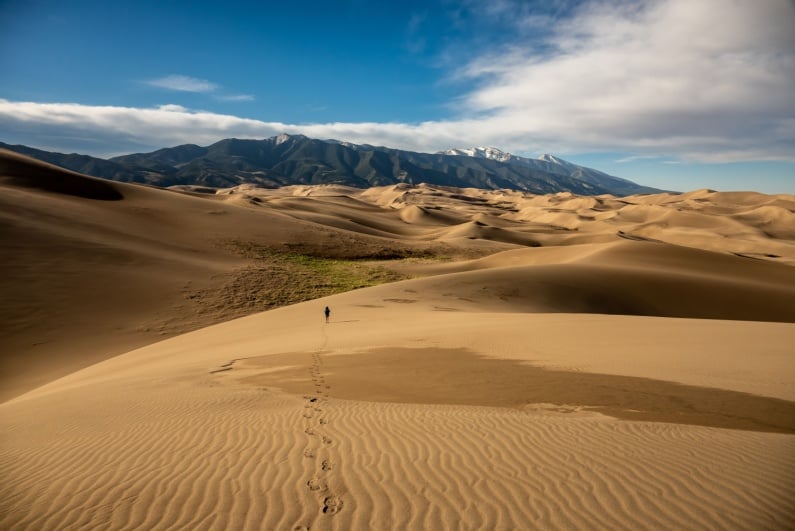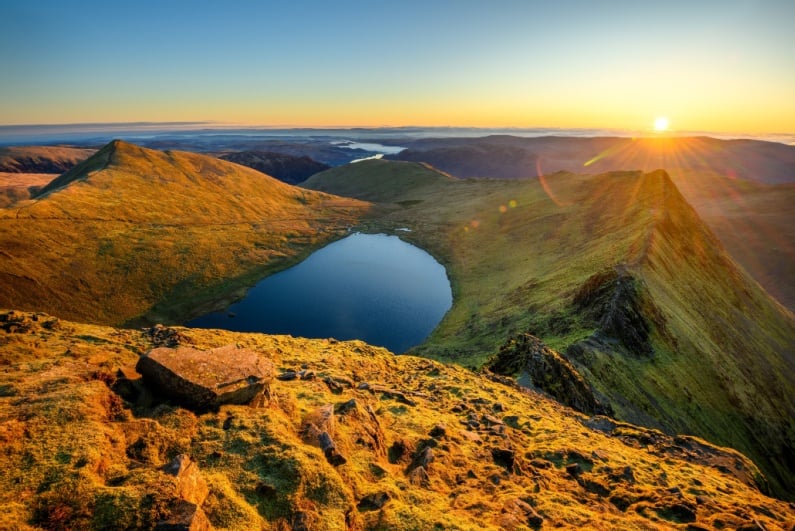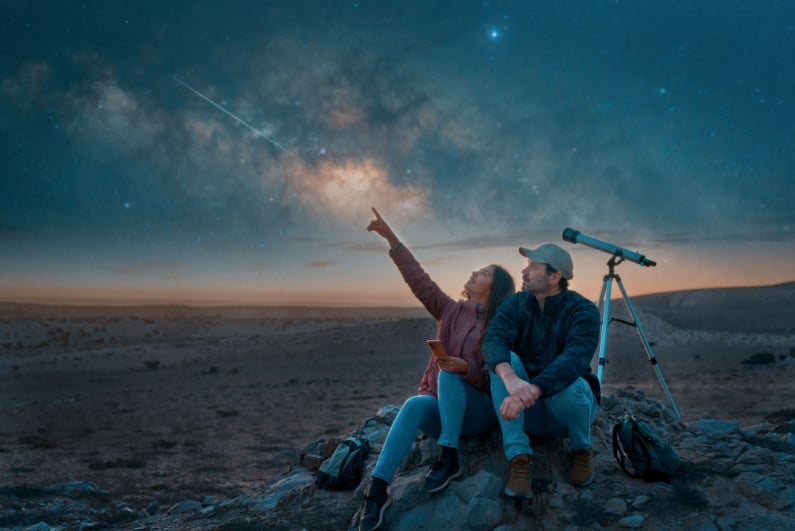In a world that moves at lightning speed – where screens glow late into the night and cities stretch endlessly toward the horizon – it’s all too easy to forget to simply look up. Our fast-paced lives often leave little room to appreciate the natural wonders quietly unfolding above us. Yet, even amongst the glow of the modern world, there remain rare and protected pockets of beauty: national Parks, places where nature is preserved, silence reigns, and the night sky offers a spectacle more breathtaking than anything on a screen. But which ones are the best for stargazing, across the US and the UK?
Our team at VegasSlotsOnline has analyzed over 40 national parks across the US and UK, based on key indicators of light pollution and night sky visibility. These include:
- Sky Quality Meters (SQM): Measures the darkness of the night sky – a higher score indicates a darker sky, better for stargazing
- Sky Brightness (mcd/m²): Reflects how much light is in the sky – the lower the number, the clearer the stars. A score of 0.25 mcd/m² or lower is categorised as unpolluted.
- Artificial Brightness (μcd/m²): Shows how much man-made light is interfering with the view, again the lower the number, the better the conditions.
- Bortle Scale Rating: Ranks sky darkness on a scale from 1 (excellent dark-sky site) to 9 (inner-city skies) – so the lower the number, the better.
- Shutterstock Image Mentions: The number of images relating to ‘stars’, ‘shooting stars’, and ‘stargazing’, offering insight into how popular and photogenic the skies really are.
Together, these metrics reveal the national parks where you’re most likely to experience the true magic of a star-filled sky.
The Best US National Parks for Stargazing
| Rank | National Park Name | Sky Quality Meter (SQM) | Sky Brightness (mcd/m2) | Artificial Brightness (μcd/m2) | Bortle Scale | Shutterstock mentions for stargazing-related terms |
| 1 | Great Sand Dunes National Park | 21.98 | 0.174 | 3.19 | 2 | 23,211 |
| 2 | Yellowstone National Park | 21.99 | 0.172 | 1.09 | 1 | 4,547 |
| 3 | Death Valley National Park | 21.99 | 0.172 | 1.11 | 1 | 4,187 |
| 4 | Canyonlands National Park | 21.99 | 0.173 | 1.69 | 2 | 9,718 |
| 5 | Crater Lake National Park | 21.99 | 0.173 | 1.36 | 1 | 3,753 |
| 6 | Rocky Mountain National Park | 21.78 | 0.210 | 39.00 | 3 | 18,305 |
| 7 | Zion National Park | 21.95 | 0.180 | 8.68 | 2 | 8,632 |
| 8 | Big Bend National Park | 22.00 | 0.171 | 0.00 | 1 | 1,047 |
| 9 | Denali National Park | 22.00 | 0.171 | 0.00 | 1 | 523 |
| 10 | Glacier National Park | 21.98 | 0.175 | 3.33 | 2 | 4,587 |
| 11 | Grand Canyon National Park | 21.98 | 0.174 | 2.84 | 2 | 4,486 |
| 12 | Arches National Park | 21.96 | 0.178 | 6.48 | 2 | 4,377 |
| 13 | Yosemite National Park | 21.97 | 0.175 | 4.08 | 2 | 3,257 |
| 14 | Grand Teton National Park | 21.99 | 0.173 | 1.97 | 2 | 2,560 |
| 15 | Badlands National Park | 21.97 | 0.175 | 4.14 | 2 | 1,623 |
1. Great Sand Dunes National Park
Great Sand Dunes National Park in Colorado, home to North America’s tallest dunes, ranks as the top national park for stargazing in the United States. While spectacular by day, the park truly comes alive after sunset. With a SQM score of 21.98, a Bortle scale rating of two, and an impressively low sky brightness of just 0.174 mcd/m² (near the pristine limit of 0.25), it offers some of the darkest, clearest skies in the country.

As an official International Dark Sky Park, it’s ideal for viewing the Milky Way, planets and meteor showers – no telescope required. The towering dunes serve as natural viewing platforms, creating an unforgettable experience for stargazers and night photographers. Its popularity is reflected in over 23,000 Shutterstock images tagged with stars, shooting stars, and stargazing – more than any other national park.
2. Yellowstone National Park
Spanning Idaho, Montana, and Wyoming, Yellowstone National Park ranks as the second best national park for stargazing in the US. With a near-perfect Bortle score of one – the highest possible – it offers exceptionally dark skies, far from dark sources of light pollution. Its impressive artificial brightness rating of just 1.09 μcd/m² and sky brightness of 0.172 mcd/m² make it ideal for viewing everything from lunar craters and deep space star systems to planetary eclipses – and occasionally, even the aurora borealis.
Stargazing tours, offered from May through October, can help visitors find the best celestial vantage points. Despite its status as a world-renowned national park, Yellowstone’s stargazing potential remains relatively overlooked, with just over 4,500 Shutterstock images tagged for stars, shooting stars, and stargazing.
3. Death Valley National Park
Ranking third is Death Valley National Park in California, less than two hours from Las Vegas. Despite its foreboding name, the park offers some of the most breathtaking night skies in the world. Recognized as a Gold Tier Dark Sky Park, Death Valley boasts a perfect Bortle score of 1, an exceptional SQM rating of 21.99, a sky brightness of 0.172 mcd/m², and an impressively low artificial brightness of just 1.11 μcd/m² – making it an ideal setting for stargazing.
Visitors who time their trip right may even catch a glimpse of the International Space Station, along with rarely visible planets and constellations. The park’s vast, unobstructed horizons provide prime conditions for night photography, with nearly 4,200 Shutterstock images tagged for stargazing-related terms. Popular viewing spots include Zabriskie Point, Mesquite Flat Sand Dunes, and Harmony Borax Works, each offering iconic desert backdrops to complement the star-filled sky.
4. Canyonlands National Park
Utah’s Canyonlands National Park looks like a cinematic masterpiece, offering breathtaking views both under the sun and stars. While its Bortle score of 2 is slightly higher than the darkest locations, it still provides near-pristine conditions for stargazing. The park’s impressive sky quality meter (SQM) rating of 21.99 means that thousands of stars are visible to the naked eye, and if you’re lucky enough, even basic binoculars can reveal the rings of Saturn.
It’s no wonder Canyonlands has become a favorite for photographers, with nearly 10,000 Shutterstock images capturing its star-filled skies. Whether gazing from the Island in the Sky or peering into the inky void above the Needles District, the park offers an unforgettable night sky experience.
5. Crater Lake National Park
Rounding out the top five is Crater Lake National Park in Oregon, home to the deepest lake in the United States. Its glassy waters offer a rare and magical sight: the reflection of the Milky Way shimmering across the lake’s surface. Yet with only around 3,700 starry-sky images on Shutterstock, Crater Lake remains a somewhat under-the-radar stargazing gem. Its pristine night conditions, marked by a perfect Bortle score of 1, an SQM of 21.99, and low artificial brightness of just 1.36 μcd/m², make it an ideal destination for those seeking awe-inspiring views without the crowds.
The Best UK National Parks for Stargazing
While the U.S. boasts some of the world’s most spectacular national parks and stargazing destinations, the UK holds its own with a surprising array of dark-sky gems – many of which based in the North. From remote moorlands to rugged coastal parks, the UK offers breathtaking celestial views that rival those of North America.
| Rank | National Park Name | Sky Quality Meter (SQM) | Sky Brightness (mcd/m2) | Artificial Brightness (μcd/m2) | Bortle Scale | Shutterstock mentions for stargazing-related terms |
| 1 | Lake District National Park | 21.81 | 0.204 | 32.6 | 3 | 130,338 |
| 2 | Cairngorms | 21.95 | 0.179 | 8.0 | 2 | 48 |
| 3 | Northumberland National Park | 21.86 | 0.194 | 22.8 | 3 | 384 |
| 4 | Exmoor | 21.81 | 0.204 | 32.4 | 3 | 29 |
| 5 | Dartmoor National Park | 21.70 | 0.226 | 55.2 | 3 | 287 |
| 6 | Eryri (Snowdonia) National Park | 21.69 | 0.229 | 57.5 | 4 | 393 |
| 7 | Yorkshire Dales | 21.68 | 0.231 | 59.4 | 4 | 83 |
| 8 | Pembrokeshire Coast | 21.63 | 0.242 | 70.5 | 4 | 284 |
| 9 | North York Moors | 21.61 | 0.244 | 73.3 | 4 | 106 |
| 10 | Bannau Brycheiniog (Brecon Beacons) | 21.54 | 0.262 | 90.4 | 4 | 150 |
1. Lake District National Park
Tucked away in the northwest of England, the Lake District National Park ranks as the UK’s top national park for stargazing. Far removed from the country’s major urban centers, it offers impressively dark skies by British standards, with a sky brightness of 0.204 mcd/m² – qualifying as pristine and unpolluted – and a relatively low artificial brightness of 32.6 μcd/m². Though its Bortle score of 3 means some of the faintest celestial sights may be harder to see compared to U.S. locations, the Milky Way remains clearly visible, along with seasonal phenomena like the zodiacal light in spring and autumn.

What truly sets the Lake District apart, however, is its popularity among night sky photographers. With over 130,000 Shutterstock images tagged for stargazing-related terms for the region – and more than 60,000 of those featuring shooting stars – it’s clear this picturesque park offers not only great odds for spotting meteors, but also a breathtaking backdrop for capturing them.
2. Cairngorms
Further north in the heart of the Scottish Highlands, not far from Inverness and Aberdeen, lies the Cairngorms – a stunning mountain range that also claims the darkest and most unpolluted skies in the UK. With a rare Bortle score of 2, an exceptionally low artificial brightness of just 8 μcd/m², a sky brightness of 0.179 mcd/m², and an SQM score of 21.95, it tops the list for sheer sky quality.
Winter is the most ideal time to visit this remote region, especially during events like the Orionid meteor shower – a dazzling celestial display often described as nature’s own fireworks. Yet, despite its pristine skies, the Cairngorms remain surprisingly underappreciated, with only 48 starry sky images on Shutterstock. That scarcity makes it a true hidden gem for stargazers, perfect for a romantic escape under a sky full of stars.
3. Northumberland National Park
Another northern gem for stargazing is Northumberland National Park, located in the northeast of England just above Newcastle. Recognized as the largest Gold Tier Dark Sky Park in Europe, it’s a haven for celestial enthusiasts and home to multiple observatories, including the renowned Kielder Observatory.
With an SQM of 21.86 and an artificial brightness of just 22.8 μcd/m², Northumberland boasts the second most unpolluted sky on the UK list. Winter offers the best conditions for viewing deep sky objects like nebulae and galaxies, while summer skies reveal star clusters, shooting stars, and even detailed views of the moon and the sun’s surface through solar telescopes. Whether you’re a seasoned astronomer or a curious visitor, Northumberland’s combination of professional facilities and awe-inspiring skies makes it a must-visit for stargazing in the UK.
4. Exmoor
Tucked away in the southwest of England, Exmoor National Park ranks as the fourth-best national park in the UK for stargazing. As a Designated International Dark Sky Reserve, it boasts exceptionally low light pollution, with a SQM reading of 21.81, an artificial brightness of 32.4 μcd/m², and a sky brightness of 0.204, ideal conditions for viewing the Milky Way and a sky full of stars with the naked eye. Thanks to collaborative efforts between local councils, businesses, and residents, Exmoor has managed to preserve its dark skies, where up to 3,000 stars can be seen, compared to around 200 in urban areas.
While stargazing is magical year-round, mid-October offers the darkest skies and is considered the best time to visit. It also coincides with the Exmoor Dark Skies Festival, a celebration filled with stargazing events and activities that make the most of this celestial spectacle.
5. Dartmoor National Park
Rounding out the top five is Dartmoor National Park, another gem in Devon’s scenic landscape. While its artificial brightness is slightly higher than the top contenders (measuring 55.2 μcd/m²), Dartmoor still offers excellent stargazing conditions, with a SQM reading of 21.70 and a sky brightness of 0.226, making it one of Southern England’s top destinations for observing the night sky.
Among the best spots to set up for stargazing are Haytor Rocks, known for its sweeping, unobstructed views and convenient 24-hour parking. Hound Tor and Meldon Reservoir also provide stunning, remote vantage points ideal for night-sky photography or simply soaking in the stars. For the clearest experience, aim for moonless nights in autumn or winter, when the skies are darkest and the stars shine brightest.
How to increase your odds of seeing a shooting star
While part of the magic of stargazing lies in its unpredictability – celestial events are never guaranteed and often come down to timing and luck – there are plenty of ways to increase your chances of witnessing something extraordinary. Much like a gamble, spotting a shooting star depends on the right conditions aligning. Whether you’re hoping to catch a meteor shower, glimpse a lone shooting star, or spot one of our galaxy’s distant planets, a little planning can go a long way.
Visit a dark sky location
Light pollution is one of the biggest barriers to stargazing. Bright city lights can wash out even the most dazzling celestial displays, so your best bet is to head for rural areas or certified Dark Sky Parks, like the ones highlighted above. These protected locations are specially designated for their low levels of artificial light and pristine viewing conditions – giving you the best possible chance to spot something spectacular.
Check calendars for peak dates and visibility windows
Astronomers often predict the timing of meteor showers, planetary alignments, and other celestial events down to specific days – or even hours. Use resources like online night sky almanacs, meteor shower trackers, and astronomy apps to plan your trip around these peak moments. Also, be mindful of the seasonal strengths of different locations: while some parks offer clearer skies in winter, others shine brightest in the summer.
Don’t forget to check the weather forecast too. Clear skies are essential – aim for areas with 0–20% cloud coverage for optimal visibility. Even minimal cloud or haze can obscure your view entirely.
Adjust your eyes, but don’t rely solely on them
Your eyes will need time to fully adjust to the dark, typically around 30 minutes. During this time, you should avoid looking at your phone or any bright light as this could hinder how well your eyes adjust. If you need your flashlight to make your way around the National Park, use a red light, or put a piece of red cellophane on your flashlight. This will minimize the effect of the light on your adjusting eyes.
And while the naked eye can reveal a wealth of stars and phenomena, tools like binoculars or telescopes can greatly enhance your view – especially for spotting planets or lunar details. If you’re near an observatory, consider booking a session for an even deeper dive into the cosmos.
Visit during the new moon
The moon itself can be a source of light pollution. For the darkest skies and best chance of seeing fainter stars or meteors, plan your visit around a new moon, when the moon is not visible. This ensures the sky is at its absolute darkest, allowing even the most subtle celestial events to stand out.
Be patient
Stargazing rewards those who wait. Meteor activity often comes in bursts – you might see nothing for 15 or 20 minutes, and then suddenly witness several in a row. Bring a blanket or reclining chair, settle in comfortably, and give the night sky the time it needs to reveal its wonders.
Methodology
To uncover the best stargazing spots across the US and the UK, we analyzed the US’s 30 most-searched national parks on Google and the UK’s 15 national parks. Each was ranked based on the following metrics:
- Sky Quality Meter (SQM)
- Sky Brightness, measured in mcd/m²
- Artificial Brightness, measured in μcd/m²
- Bortle scale
- Shutterstock mentions for ‘stars’, ‘stargazing’ and ‘shooting star’ in each location analyzed
All metrics were weighted equally to calculate the final ranking. Data collection took place in June 2025.




